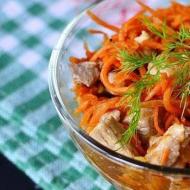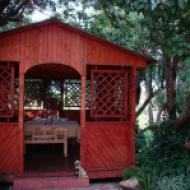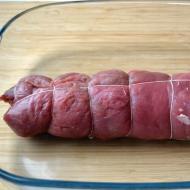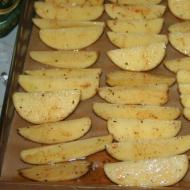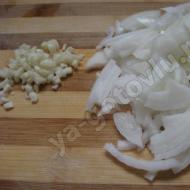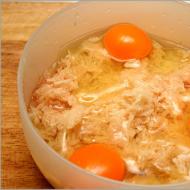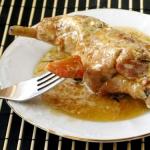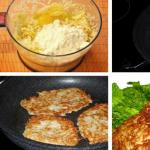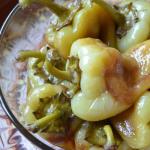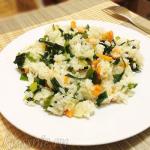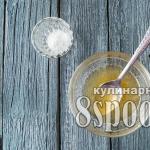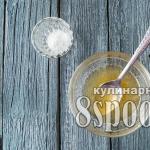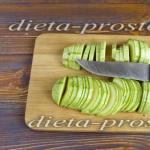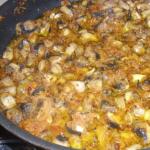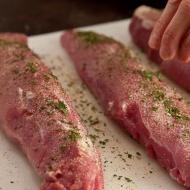
Easy salt dough crafts for kids. Sculpt with the kids! Salt dough - dough recipe and how to work with it. Salt dough asterisk is ready
An article for those who like to engage in creativity with a child. It contains recipes for salt dough for modeling and many ideas for crafts.
Modeling is a fun and useful activity at the same time. Making figurines, paintings, compositions from plastic material, the child develops imagination, logical thinking, fine motor skills, and learns perseverance.
Of course, a mother can simply buy plasticine or some branded mass for modeling for a baby. But how high quality and environmentally friendly these materials are? Alternatively, you can use homemade salt dough from inexpensive natural products.
How to make dough for crafts?
Ecological cleanliness is not the only advantage of salt dough over plasticine or play-doh.
- The recipe according to which the plastic mass is prepared does not cause any difficulties for absolutely anyone. If a child asks to sculpt while in the country, for example, and there is no plasticine at hand, it will be possible to fulfill his desire in half an hour
- Modeling materials in the store are quite expensive. Salt dough ingredients are much cheaper
- Salt dough, even the one to which paints have been added, does not stain hands, does not stick to fingers. It is soft and pliable
- Dough crafts can be dried using a special technology. Then they will be stored for a long time and serve as a souvenir, Christmas tree toy, children's toy.
IMPORTANT: Even in ancient times, people mastered modeling from dough with salt. A whole art arose, which was called testoplasty. The women and children made very fine crafts, hand-painted them and used them as home decorations. Figurines, symbolizing various benefits, were considered expensive gifts, presented only to close people. Our ancestors did not “wrap up” with a salt dough recipe, making the material only from water, flour and salt.
Today, salt dough modeling, which has suddenly returned to popularity, is called bioceramics. The recipes for the dough itself are being improved. Unfortunately, some of them involve the use of wallpaper paste, synthetic paints, etc. The concept of absolute naturalness is lost.

There are three main components in the composition of salt dough for modeling. It:
Additionally widely used:
- gelatin
- starch
- vegetable oil
- natural dyes (beet juice, green beans, etc.)
- food colorings
- gouache or watercolor paints
- PVA glue
- wallpaper glue
Glue or starch makes the finished dried dough figures more durable, but it is not advisable to add them to the material that is intended for children under 5 years old. And dough with butter can be greasy and stain clothes.
IMPORTANT: You can color both the dough itself while it is being prepared, and the finished figure, then creativity will be more interesting and doubly useful

RECIPE #1. simple dough
Needed: wheat flour - 1 cup, extra salt - 1 cup, cold water - 0.5 cup
First of all, dry ingredients, flour and salt will be combined. If the dough will be colored with food coloring or paint, I dissolve them in water. Gradually adding colored water to the flour and salt, knead a rather steep dough, but such that it does not stick to your hands and does not crumble into crumbs.
IMPORTANT: To check if the mass is suitable for modeling, a smooth ball is rolled out of it, a hole is pressed through the middle of it with a finger. The dough should neither spread nor momentarily return shape. The edges of the recess must remain even.
RECIPE #2. dough with starch
You need: wheat flour - 0.5 cups, starch - 0.5 cups, extra salt - 1 cup, water - 0.5 cups.
Just as in the first case, flour, salt and starch are first mixed. Then gradually add pure or tinted cold water. The mass for modeling, which contains starch, becomes more elastic.
In addition to the most salty modeling dough, you need to cook:
- plank
- knives - stacks
- molds (such, for example, come with the play-doh test)
- beads, sequins, buttons, other improvised materials for decorating crafts
IMPORTANT: Flour and salt dough can be used several times in a row. To avoid it drying out, the material is placed in a plastic bag or wrapped in cling film, then closed in an airtight container and sent to the refrigerator.
How to dry dough crafts?
If the dough crafts are small, they will dry on their own. To prevent cracks from appearing on their surface, they are removed from direct sunlight.

You can also dry the figures from the dough in the oven with a minimum temperature and always with the door ajar. In the oven, the dough is dried for 3 - 6 hours, depending on the size of the craft. She goes to the oven three times for 1 - 2 hours, between each time there is a short break.
Making salt dough with children
For the first time, you can offer salt dough to a baby as early as the age of 1 year. This is not chemical plasticine or play-doh mass, the mother may not worry if the baby tastes the material or swallows it. For such small "home-made" dough is prepared without synthetic dyes.

IMPORTANT: Modeling dough is very salty. As a rule, it is enough for a child to lick it to understand that it is not edible. But if the baby still ate a piece, you just need to give him plenty of drink, and if mom is still worried, and a bag of Smecta
Full-fledged developmental modeling classes are possible with children from 2 years old. From rolling circles and balls out of salt dough, they will smoothly turn into real creativity, in which kids will be able to mold flowers, animals, favorite fairy-tale and cartoon characters, and more.

The final result of modeling from dough is as important for kids as the process itself. The finished craft causes them strong positive emotions.
Dough crafts for children in kindergarten
No need to think that salt dough is a “handicraft” material exclusively for homework. Kindergarten teachers have long taken note of the recipes for plastic material and are happy to replace plasticine with them in developmental classes with pupils.

So, in nurseries, casts of babies' hands, circles, mushrooms, "sausages", snails, etc. are often molded. In older groups, children are already poring over themed crafts, for example, for the holidays.
Dough crafts for kids. Step-by-step dough crafts
When sculpting from dough with kids, you don’t need to come up with ideas for crafts: usually, they are born by themselves at the moment when the fingers touch the plastic material. Children love to sculpt
- geometric figures
- flowers and trees
- fruits and vegetables
- animals
- dinosaurs
- little men
- fairy creatures
- cartoon characters

Adults, mastering testoplasty, can get ideas on the Internet, there are many step-by-step master classes.
IMPORTANT: Good benefits for both children and beginner adults are the books “Salty Dough Step by Step” by V. Khomenko and “Miracles from Salt Dough” by A. Firsova
Templates for crafts from the dough. Children's crafts from salt dough
Salt dough crafts can be very beautiful. Children's crafts have their touching charm. Adults are like pottery.
To get inspired for creativity, you can view a selection of thematic photos with crafts from salt dough.
Salt dough panels and pictures
Such works of bioceramic art can be hung on the wall or placed in a conspicuous place. Salt dough photo frames are also very beautiful.



New Year's crafts from salt dough
On New Year's Eve, you can make not only Christmas decorations from dough, but also gifts - souvenirs for friends in the form of a symbol of the year. In 2016, this is a funny monkey.




Crafts from the test for February 14 for Valentine's Day. Crafts from salt dough heart
The heart is the symbol of Valentine's Day. Made with your own hands from flour, salt, water and, of course, love, it will turn into a very valuable gift.
A cute angel made of salt dough also looks very nice.


Video: Angel on February 14
Crafts from the dough by February 23. Salt dough craft
On February 23, instead of a banal postcard, you can give men cute crafts from dough: the number 23, any symbols of courage, for example, weapons, cars, military equipment.



Crafts from the test for March 8. We make flowers from salt dough. Dough rose craft
Any mother will be touched by a craft given to her by her beloved child for the holiday of March 8. Most often these are flowers, bouquets, flower arrangements. Dough roses will never wither.




Gorgeous basket of flowers.
Video master - a class on making roses from salt dough
Crafts from dough for Shrovetide. Easter crafts from salt dough


Stand - chicken for Easter eggs.

Easter crafts made from salt dough will bring a special flavor to the bright holiday
Salt Dough Crafts Animals
From salt dough together with the baby you can fashion a whole zoo!



Figurines - cats.

Video: how to make a cat - a fridge magnet?
Crafts from salt dough birds. Sculpt fish from salt dough
It is difficult to make birds and fish in testoplasty, but they do not turn out beautiful.
Such products are delicate work.
What crafts from salt dough to choose for a child of 5 years?
Forcing a five-year-old child to sculpt something that an adult wants is simply impossible. He needs to be interested. The kid should be offered several ideas, let him choose the one that he likes best.
Video: salt dough - recipe for crafts
It is difficult to overestimate the benefits and advantages of salt dough in the arsenal of an enthusiastic mother. First of all, it is its environmental friendliness. The dough consists of natural ingredients, so accidentally getting into the baby's mouth will not cause unnecessary worries for the mother.
The ease of manufacture and the availability of ingredients make salt dough versatile with the child and the development of fine motor skills. And what is important - the dough turns out to be quite a lot, and there is no need to divide it into a small piece (if you are sculpting together), as is the case with plasticine from a pack.
Dough recipe and dyes
There are many different recipes for salt dough. Basically they are divided into two types:
- With heat treatment;
- Without heat treatment.
- 1 st. flour;
- 0.5 st. fine salt "Extra";
- 1 tbsp starch;
- 0.5 st. cold water (from the refrigerator).
First, all solid ingredients are mixed, then water is added in portions and the dough is kneaded. Ready-made salt dough does not stick to hands.
The mass for modeling can be left in a natural color or a dye can be added during the kneading process. If you want to make the salty dough colorful, then divide the finished dough into several parts, add the necessary dye and knead well again (we used the last option).
Dyes you can use:
- food (for coloring Easter eggs);
- natural (coffee or cocoa give different shades of brown, paprika - orange, spirulina (dietary supplement, sold in a pharmacy) - green, turmeric - yellow).
The dough turned out soft and elastic. Such a composition is suitable for sculpting flat and semi-volumetric figures (for example, the elephant that we blinded began to “blur” after 10 minutes, and the hedgehog remarkably retained its shape). Of the minuses - after sculpting, powder from flour and salt remains on the hands, unlike hot-cooked dough.
Materials and fixtures
Of course, you can only get by with salt dough and have a wonderful time with your baby. However, the following materials will help you significantly diversify your studies.
For shaping can be used:
- cookie cutters;
- Pasochki from the sandbox (after washing them);
- Covers of different diameters;
- Self-made stencils from cardboard (prepare stencils of parts of the drawing according to the principle, then apply them to the rolled out dough and cut along the contour with a children's knife or stack).
For embossing and creating all kinds of prints will come in handy:
- Lace paper and textile;
- Caps from felt-tip pens;
- Drill (preferably not new with a blunt end);
- Fork;
- Cocktail tube (it is convenient to make holes in pendants or openwork pendants);
- Sticks of different diameters;
- Relief plants (juniper, maple leaves);
- Shells.
For decorations crafts fit:
- Pasta of various shapes;
- Groats (beans, peas, chickpeas);
- Plant seeds (watermelon, sunflower, pumpkin);
- Seasonings (black pepper, cloves);
- Buttons and beads.
In addition, handicrafts will come in handy: a rolling pin, garlic press and nail scissors
Salt dough craft ideas for kids
Now let's see what can be done with the child using the above materials.
handprint
Many parents make a plaster cast or an imprint of a baby’s hand / foot as a keepsake for a year old child. The same can be done with salt dough.
We roll out a layer 1-1.5 cm thick, with the help of a small bowl we cut out a circle of a suitable diameter, attach the baby’s handle and help to press it well to the dough.
On the side we make an inscription: the date or age of the baby and send it to dry. 
Do you want to play with your child easily and with pleasure?
Pendants and pendants
We roll out the dough and squeeze out a circle of a suitable diameter. Together with the child, we fill the circle with various materials for decoration.
Another option: we make all kinds of prints on the rolled surface, and then we cut out the area we like with the help of cookie cutters.
When all the preliminary work is over, we form a hole for hanging with a cocktail tube and dry it. 
In order to make an openwork pendant, carefully make holes in the dough with a cocktail tube, turning it slightly at the end so that the dough remains in the tube.
Owl
A simple craft that a child from 3 years old can handle. Roll out the dough with a thickness of 0.5-1 cm and cut out a circle. In the lower part, using the cap from the felt-tip pen, we make semicircles - the plumage of an owl. Next, we bend two semicircles to the center - these are the wings and from above we bend a small semicircle - the head of an owl. We make eyes by pressing the closed part of the cap on the appropriate places and form the mouth of an owl with a stack. With your fingers, we correct the small ears at the place where the semicircles overlap. The owl is ready!

Hedgehog
For this craft, we need nail scissors and black pepper for the eyes. We roll the ball, after which we slightly stretch one of its sides, forming the muzzle of a hedgehog. With the help of manicure scissors, we make triangular cuts over the entire surface of the future “fur coat”, at the end raising the dough up a little - these are hedgehog needles. From black pepper we make eyes and a nose to a hedgehog. Our forest animal is ready! 
caterpillar and snail
These are crafts for the little ones. For the snail, we roll out two sausages: one long narrow, the second short, but thick. We turn the narrow one into a spiral, forming a snail's house and put it on a thick base. We make eyes from black pepper, and horns from small sausages.
For the caterpillar, we roll a thick sausage and a few balls. We place the balls on the sausage, pressing them with a stick or the back of the brush. With the same stick we press on the side surfaces of the caterpillar and insert the eyes - peas.

And finally, inspiration for indecisive moms who put off salt dough modeling because of doubts about what they are. Even if the result of your joint creativity is such an animal / bird of an unknown breed as in the photo below, the child will be happy and will show off his product to everyone.
The dots on the head and furrows on the tail are made with a fork. Small balls are fixed with a round stick, and large ones are fixed with pressed beans.

Drying products and their coloring
If your child does not immediately seek to disassemble the craft, and you decide to save it, then there are two ways to dry products from salt dough:
- Natural drying. The craft is left at room conditions, and it dries on its own at 1 mm per day.
- Drying in the oven. They try to sculpt such crafts on foil so that the product does not deform when transferred. In addition, only natural materials should be used (without buttons, beads, etc.). The craft is placed in the oven for 1 hour at a temperature of 50 degrees. If the craft is voluminous, then alternate periods of drying in the oven and in natural conditions.
If you initially sculpted from unpainted dough, and then wanted to paint the craft, then you can do this only after it has completely dried, otherwise the paint will crack.
You will learn how to mold a basket with mushrooms from this video:
Have you tried making with salt dough? Tell me in the comments?
Greetings, dear parents, readers of our blog! Recently, the old technique for the development of fine motor skills of a child has been revived - modeling from dough. And today I want to tell you more about salt dough for modeling. Recipes with photos can be found at the end of the article.
Modeling is a great opportunity for adults to express themselves or relax, as well as develop fine motor skills and imagination for children. Crafting with kids is fun and exciting. The big advantage of salt dough modeling is that it will cost you much less than other materials for children's creativity.
For modeling, you can use potter's clay, plasticine, and ordinary dough during the joint preparation of cookies or dumplings. Children are very fond of sculpting and rolling balls from such materials. Salt dough is used exclusively for creativity, because it is inedible.
It has long been sculpted from salt dough:
- Protect;
- Kids toys.
Now this type of creativity is becoming popular again, you can make from dough:
- decor items;
- Figurines, toys;
- Paintings;
- Baby's hand or foot prints.
It is no secret that adults are very fond of doing this type of modeling, preferring salt dough to clay or gypsum, they fashion whole pictures that decorate the house or are given as a present:

2. Why Salt Dough
It is surprising to many to hear that the dough must be salty so that something can be molded from it. The fact is that you can sculpt something from any dough, because it is always plastic, but not from any dough you can make crafts that will be stored for a very long time without losing their appearance.
The secret material - salt - cements the dough, so the products keep after drying. The main ingredients of this test are:
- Flour;
- Salt;
- Water.
In addition, you can add other components, depending on what you want to get. It can be glue, oil or paint, which can be added to any recipe. But the main thing here is salt, which should be finely ground and without impurities (iodine).
3. Salt Dough Recipes
There can be many recipes, consider a few of them. You need to choose the simplest flour, without additives, and the water is very cold.

3.1. Salt dough regular
Compound:
- Wheat flour - 1 tbsp.;
- Salt - 1 tbsp.;
- Water - 0.5 tbsp.
How to make modeling material from these ingredients?
- You need to mix flour and salt, then gradually pour in water, quickly mixing everything with your hands.
- Knead the dough for a short time, if it turns out to be tight, add a little more water.
- If the dough is sticky, add some flour. It all depends on the flour, so sometimes you need more water, sometimes less.
3.2. Salt dough with rye flour
Compound:
- Rye flour - 1 tbsp.;
- Wheat flour - 1 tbsp.;
- Water - 0.5 tbsp.;
- Salt - 1 tbsp.;
- Oil - 1 tbsp.
Rye flour will give the product a soft brown color, especially if it is dried in the oven. Rye flour alone is not used, as the dough will turn out to be very tight and difficult to fashion something out of it. The oil will give the dough elasticity, it will not stick to your hands.
3.3. Salt dough with glue
Compound:
- Flour - 2 tbsp.;
- Salt - 1 tbsp.;
- Dry wallpaper glue - 2 tablespoons;
- Oil or glycerin - 4 tablespoons;
- Water - 125 ml.
- First you need to combine flour and salt, then add glue diluted in water.
- Mix everything and add oil.
- If the mixture is sticky, add some flour. In addition to wallpaper glue, PVA glue is used, this is done for the strength of the material.
How to cook colored dough?
To color the dough, you can add food coloring or natural juice, adding drop by drop and mixing with the finished mass. In addition, you can paint the finished craft after it dries using art paints.

4. Crafts from salt dough
As soon as the baby is 1-1.5 years old, he can be introduced to the test as a way of playing and developing.
The advantage of the test is that the child will not get poisoned if he tries it, and it also does not smell like plasticine. Such a natural material is an excellent tool for making crafts. The dough can be stored in a bag in the refrigerator for several days.
A child of any age can use the salt dough modeling technique, gradually complicating the task. For beginners, sculpting small simple figures is best suited.
The child can do the following:
- Roll out the dough with a rolling pin;
- Cut out figures from it with molds (from the designer, cubes or cookie cutters);
- Sculpt sausages, balls;
- Combine several elements into one figure (attach buttons, sticks, beads to the figure);
- Make hand or foot prints on rolled out dough;
- Paint dried figures or crafts with paints (watercolors, a mixture of gouache with PVA glue, acrylic paint) - under the supervision of adults.
The child can stick different elements on a thin layer of dough, creating pictures. Also, ready-made flat figures can then be glued to the canvas and inserted into the frame, getting a work of art.

5. Drying salt dough products
There are such types of drying:
- on air;
- in the oven;
- on the battery;
- in the sun.
One way or another, the products must be dried well. If the dough layer is thin, it will take less time. Volumetric pictures from dough or figurines need a long drying time.
The surest and easiest way is to air dry, preferably warm, but not in direct sunlight. For a product up to 1 cm thick, it will take 4-7 days. Then check by tapping the surface with your finger. If the sound is sonorous - the product has dried up, if it is deaf - you still need to dry it.
It will take about one day to dry on a battery, in the summer you can put the product on the windowsill.
When drying in the oven, you need to set a low temperature (50-150 degrees) with the door open. It will take about 3 hours for a thin product.
After drying, the craft can be painted or varnished to protect the surface from damage and brittleness.

You can watch a video on how to easily and simply prepare salt dough here:
Develop with your kids, sculpt and create for yourself in joy! Subscribe to updates and share the article with friends on social networks! And I'm waiting for you on our site again.
There is a lot of information on the Internet about how to knead salt dough, how to sculpt it, but at the same time, few of the masters share various small secrets on working with this interesting material. Today you will learn 11 Salt Dough Craft Secrets for Beginners that will help you create more beautiful work and make it easier to work with.
Channel: Draw with children
Salt dough recipe for crafts:
- 1 cup flour
- ½ cup water (maybe more depending on the amount of gluten in the flour)
- ½ cup salt
- vegetable oil
Pour the flour, salt into a bowl, pour out the water and knead the dough. If it suddenly turns out that there is too much water, then add a little flour. You should get a dough similar to plasticine.
1. The first secret is the secret of the dough, from which figures come out that do not crack when dried.
A very common problem with salt dough products is that when they dry, they begin to crack. What can be done to prevent this from happening? To prevent the dough from drying out and cracking, you need to add a little vegetable oil to it. For the above proportions, ½ teaspoon is sufficient.
2. In order for the finished figure from salt dough to be more durable, unbreakable and unbreakable, you need to add 2 tablespoons of wallpaper glue or PVA glue to the salt dough in the proportions indicated above when kneading. Then, after drying, the figure will become more durable and it will be impossible to break it.
3. If, when kneading, you feel that the dough is too dry and when breaking it has dry edges, dip your finger in water and brush the dough a little with a wet finger at the break point. After that, knead the dough well. If necessary, repeat.
4. The dough must be kneaded to such an extent that it is not rough to the touch. Kneading salt dough takes a very long time. It is better to knead in small portions so that a piece fits in your hand. After you feel that the dough has become smooth, put it in cellophane and refrigerate.
5. If you first sculpt from ordinary dough and paint it after drying with gouache, then the painted work must be varnished. Lacquering the surface protects the finished work from moisture, and gives additional juiciness to the colors.
Since children cannot work with varnish, it is better for children to pre-color the dough and use food coloring for coloring. To color the dough, you need to flatten a piece, pour a little dry food coloring into the middle, dip your finger in water and wet the dye. Gather the flattened dough into a ball with dye inside and begin to knead and knead it. Dough with dye is kneaded faster, it is softer and more elastic than usual.
6. If you paint the finished product with gouache, then in order for it not to stain your hands in the future, you need to add a little PVA glue to the paint.
7. If you start sculpting from dough and, having rolled out the layer, you will see cracks on it, you must definitely wet your finger with water and cover up these cracks. The surface of the future product must be perfectly flat. The appearance of cracks usually means that the dough is not kneaded well.
If a crack appears on the finished figure, then drip water on the crack so that it flows inside and gently coat until smooth. The water will help seal the crack.
8. Roll out the dough to a thickness of at least 3 mm.
9. If you are making flat figures, then when the work is ready, turn on the oven to the lowest heat and, without closing the oven, dry until completely dry. Otherwise, they will be led, they will swell and lose their shape. Very often you can hear advice that you can dry the work on the battery. However, on the battery, the dough dries for a very long time. From above, it may dry out, but inside it will be damp and may later break or deform.
10. After cutting out a flat figure, the edges are uneven and rough. Dip your finger in water and smooth the edges until smooth. Then the figurine itself will be worthy of what you can give it and not be shy.
11. When cutting out figures from dough, you cannot “pull” the knife: the dough can begin to reach for it. You need to cut out with punching movements, piercing the dough around the perimeter of the figure.
In the video master class, you can also see how to make a New Year's craft from salt dough - an angel figurine to decorate gift wrapping.

In addition, you will need foil, paints, brushes, water, colorless varnish, toothpicks and any decorative things to decorate and complement the image (ribbons, buttons, beads, feathers, eyes, etc.).
Making dough for modeling at home
My daughter eagerly participates not only in modeling and coloring, but also in dough kneading.
For cooking, take 2 cups flour and 1 cup salt. Salt should be finely ground, optimally - Extra, not iodized.
 Mixing the Ingredients
Mixing the Ingredients We mix salt and flour and, adding water in small portions, knead a rather tight dough, similar in consistency to dumplings. A little less than a glass of water is required. You can add 1 tbsp for better elasticity. l. vegetable oil.
 flour for dough
flour for dough After kneading, put the dough in a bag and leave it in the refrigerator for 1-2 hours.
 kneading the dough
kneading the dough The finished dough does not stick to your hands, easily wrinkled, keeps its shape. It can be colored in the mass, that is, add paint directly to the dough and knead. It can successfully replace soft plasticine. We paint ready-made crafts.
Interesting ideas for modeling with a child
In addition to directly sculpting various figures, salt dough can be used to make paintings. For example, my daughter and I made a small picture on the theme "Pushkin's Tales".
Step 1
They came up with a drawing and painted a small board with blue gouache.
 Step 1. Decorated the board and drew a picture
Step 1. Decorated the board and drew a picture Step 2
The details of the drawing were molded from salt dough and glued to the plank with PVA glue.
 Step 2. Sculpt dough parts and glue to a blue plank
Step 2. Sculpt dough parts and glue to a blue plank  Step 2: Adding Details
Step 2: Adding Details Step 3
The finished image was dried at room temperature for 3 days.
 Step 3. Dry the painting for 3 days
Step 3. Dry the painting for 3 days Step 4
Painted and finished with clear lacquer.
 Step 4. Coloring with paints
Step 4. Coloring with paints  Step 4. Varnish
Step 4. Varnish For young children, you can offer an interesting option for working with the test.
- Roll out the dough into a layer , cut out shapes for cookies or plasticine figures, dry.
- Recolor . Such crafts are within the power of my son at 2.5 years old.
You can make a garden of stones and other “values”: artistically place finds from a walk on a salt dough cake - pebbles, leaves, twigs.
How my daughter and I made crafts from dough
One of our recent crafts is Antarctica. Often we get ideas from modeling books from, but there are some differences in working with the test. For example, you can not sculpt separately parts of different colors, because the dough is painted in what color you need.
Also, when sculpting three-dimensional figures, foil is used as a frame, it does not allow the figure to “sink” while it is drying, and the drying process itself is accelerated.
Sculpt penguin
You will need 5 blanks-balls:
- 1 large - for the body;
- 2 small - for wings;
- 2 even less - for paws.
 Roll up balls
Roll up balls  Roll out dough balls
Roll out dough balls Place a piece of foil in the center of the large ball and shape it into a pear shape. We roll out the blanks of wings and legs into cone-shaped sausages and flatten them. We bend the workpiece of the torso to get a head with a beak.
 We form the torso
We form the torso We connect the wings and legs with the body, glue the eyes from small balls.
We put the penguin on an ice floe: rolled out a layer of dough and cut out a circle-hole with a glass.
 We collect the penguin and put it on the layer
We collect the penguin and put it on the layer Dry at room temperature for about a week.
You can not put the figures on the battery, speed up the process with a hairdryer, this can lead to cracking.
Can be dried in the oven at a temperature of 50-150 degrees for several hours.
Sculpting a seal
We also prepare 5 blanks: the torso and paws. As a frame, we use a strip of foil folded several times.
 We form balls of different sizes
We form balls of different sizes We give the body the shape of an oblong cake and place the foil in the middle. We roll the foil into the dough sausage.
 We roll a large ball into a cake and put foil on it. From small balls we make a nose and eyes.
We roll a large ball into a cake and put foil on it. From small balls we make a nose and eyes.  Collecting a seal
Collecting a seal Can be dried.
As an additional decor, we blinded the fish.
 Making a fish
Making a fish We paint the dried products with gouache and watercolor and cover with transparent varnish (you can use acrylic art, or you can use ordinary wood varnish).
 We decorate the composition and cover it with varnish
We decorate the composition and cover it with varnish The varnish has a decorative and protective function, and makes the colors brighter, and also prevents the figurines from getting their hands dirty, in general, prolonging their life.
Any art joint with children is fascinating. Modeling not only develops fine motor skills, but also awakens the imagination of the child and parent.
I assure you that during joint gatherings for crafts, you will learn a lot of new and often unexpected things about your child.

